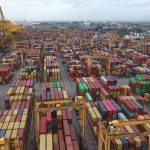Asia’s high sulfur fuel oil refining margins have surged to a 17-month high, driven by limited prompt availability and expectations for tighter overall supplies due to recent US sanctions on Russia’s energy industry, with downstream bunker demand expected to remain relatively healthy this year.
The Platts-assessed front-month crack spread for Singapore 380 CST HSFO against prompt-month Brent crude swap, which has surged nearly 38% so far in January, was assessed at minus $2.64/b on Jan. 21, the strongest since Aug. 22, 2023, when the refining margin was assessed at minus $2.20/b, S&P Global Commodity Insights data showed.
The crack spread was pegged even firmer at minus $1.75/b in midafternoon Asian trading Jan. 24, the data showed.
The M1-M2 intermonth spread for the benchmark Singapore 380 CST HSFO was assessed at a strong $8.75/mt in the week started Jan. 20, marking the widest backwardation in nearly two months since Nov. 29, 2024, when the spread was assessed at $9.45/mt, Commodity Insights data showed.
While the spread eased marginally over the last couple of sessions and was assessed at $8.45/mt on Jan. 23, it was still about 52% firmer compared with end-December, the data showed.
“In the paper market, the 380 CST HSFO has gone up a lot. Of course, a lot of the Russian production is high sulfur, so it will affect the HSFO market more than LSFO, but there are some people who use Russian 1%S material for LSFO blending… But it will be mainly the HSFO market that will be impacted, and we will see those premiums jump,” a Singapore-based trader said.
“There will always be some people selling sanctioned material in the market. But there will still be those who would need legit oil and will be ready to pay higher premiums in the HSFO market,” the trader said, adding that although the Middle East summer has ended, they were not seeing sizeable volumes of HSFO coming from the region into Asia, except for some steady shipments from Saudi Aramco.
The Platts-assessed Singapore 380 CST HSFO cargo’s cash differential to the Mean of Platts Singapore 380 CST HSFO assessment, which has jumped about 35% so far in January, was assessed at a premium of $8.67/mt on Jan. 23, Commodity Insights data showed.
Bunker demand outlook boosts sentiment
The Asian HSFO bunker market is expected to receive support from a continued rise in scrubber-installed ships in 2025, as shippers opt for the high sulfur grade due to the significant reduction in scrubber installation costs compared with the initial phase following the International Maritime Organization’s 2020 regulations, Commodity Insights reported earlier.
Singapore’s bunker sales reached a new record high of 54.92 million mt in 2024, up 6% from the previous record in 2023, data from the Maritime and Port Authority of Singapore showed. HSFO sales accounted for 36.8% of total volumes in 2024, up 4.5 percentage points year over year, while LSFO sales were down 4.9 percentage points year over year.
Positive sentiment in Singapore’s HSFO downstream market is expected to extend into 2025, with steady term contract volumes supporting sales and stocks generally adequate for the delivered market. However, the recent slate of fresh sanctions has stirred supply concerns among sellers.
“We are watching this [supply] situation carefully; HSFO isn’t short or delayed yet, except for tighter barging [slots]. For suppliers sourcing Russian cargoes, there isn’t much reaction yet either,” a bunker trader said.
Traders foresee that the buoyed HSFO valuations in the near term could be partly sentiment-driven, and any potential impact on arbitrage flows could only surface within a few weeks or later in February.
The Platts-assessed Singapore-delivered 380 CST HSFO bunker premium over the FOB Singapore 380 CST HSFO cargo value averaged $19.77/mt over Jan. 2-23, up from an average of $18.71/mt in December, Commodity Insights data showed.
China’s feedstock demand may disrupt outlook
While the Asian HSFO market has recently been boosted by tighter supplies, traders remain wary of potentially weaker feedstock demand from China, especially after the country raised its fuel oil import tariff to 3% from the previous 1%, effective Jan. 1, Commodity Insights reported earlier.
“It is all a bit hard to tell [now]. China’s exports seem better than expected, and I don’t see Russian volumes tightening as of yet. Vessels that went on the US Treasury Department’s Office of Foreign Assets Control list can still trade until March 12 if cargoes were loaded before Jan. 10 … China’s imports will slowly taper off from February onward,” another trader said.
Additionally, a statement issued Jan. 6 by Shandong Port Group, owned by the Qingdao city government, declared that shipping companies and ship entities on the OFAC sanctions list would be prohibited from docking, unloading and receiving any port services at its ports.
Source: Platts





